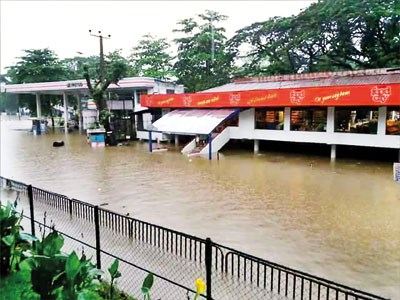‘Seven Trails’ – Natural Disaster Readiness for Corporates
View(s): A flood of water was what it appeared at the outset – and a ‘flood of tears’ what it really was in the end.
A flood of water was what it appeared at the outset – and a ‘flood of tears’ what it really was in the end.A year after the 2016 floods – and 13 years after the 2004 Tsunami -, we were mercilessly tested for the ‘Aqua Challenge’ once more and it exposed our readiness deficiencies too.
Flash floods could be our recent most focal-point, but protection from natural disasters is a discipline of a much wider spectrum.
Corporates need to capture meaningful learning from every natural tragedy, no matter how random the event appears to befall. The business must be ready – not ‘if’ – ‘when’ upheaval hits us out of the blue.
Trail 1: Site:
Certain corporates realize that over-dependency on yet maturing state disaster response and recovery mechanism is not the finest path to tread. One such stretch-sighted and responsible business here started its disaster management preparedness at the site itself.
The water risk, windstorm risk, tremor risk and natural fire risk were a few things that the investing management was focusing at the project conceptualization stage. Not every business, every site will have the luxury of this modality constantly, but at all possible times, site risks need to be well calculated.
Trail 2: Fortification:
The blueprint stage of the design should incorporate the applicable Water Barriers, Wind Barriers and Fire Gapping – both in the structural zone and in the landscape. The core objective of the fortification is to mitigate the impact of the initial moments so that a reasonable lifesaving and asset saving time is created.
Natural disaster risk factors become challenging when sites are taken on leased basis where space for choices gets slimmer. Sometimes, operating next to a potential disaster zone becomes inevitable too for assorted reasons. Yet, a business can make fortification meaningful by continuous impact mitigation improvements and status verification.
Trail 3: Planning:
‘When in peace – plan for war. When in war – plan for peace’ said Sun Tzu. This ancient adage serves gold in planning for natural disasters too. We ought to prepare for rain while enjoying bright sunshine.
Disasters bring madness – and response planning is our effort in creating some method to madness.
Natural disaster response planning takes a diverse approach for stand-alone sites and countrywide networked sites. Sometimes a business site may be producing an essential commodity or engaged in time critical export operation or providing a key utility across the territory.
Disaster trend comprehension and calamity monitoring need to be a dedicated round the clock commitment linked with effective alerting and emergency communication looping.
The immediate response plan should be focusing on life safety where it may require rush-appropriate egress of occupants – be it staff, customers, guests, disabled or visitors to pre-determined refuge points. The rescue of the trapped needs to be planned with specific external action agencies.
The response plan also needs to be focused on the salvage of cash and bullion, vital literature, machinery, stocks, fleet and upstream or downstream supply depots – within prevailing practicality.
 Trail 4: Resourcing:
Trail 4: Resourcing:
Disaster response resourcing and its logistics is a scientific art as we realize with the poetic verse below.
‘For want of a nail, the shoe was lost; for want of a shoe, the horse was lost; for want of a horse, a message was lost; for want of the message, the battle was lost; for want of the win, the Kingdom was lost – ALL for the want of a horse-shoe nail.’
No matter how best our plan is illustrated on paper, if we fail to invest in right resourcing, our response is nothing shorter than an outlandish failure at the life critical moment. It could be teaming, monitoring facility, communication tools, alternate power supply, disaster specific first aid or evacuation and rescue tools.
Resources placement is another essential factor to reckon with. The balance of internal and external placement in calculated proportions of (both) centralization and scattering should be maintained.
Trail 5: Competence:
Disaster response is not any man’s or everyman’s forte. Those in response voluntarily (and perhaps unconsciously) put their life on the line of peril. Thus, creating the response awareness and competence for all types of potential disasters can save lives, assets and the brand status too.
Creating the know-how and response competence can take the following contour.
- Awareness – Tier 1
- Awareness – Tier 2
- All staff awareness
- ER team training
As great William Shakespeare vividly said, ‘All things are ready, if our mind is so’. Prepare the minds – and our bodies will respond accordingly.
Trail 6: Testing:
No disaster response plan is track-ready until put to test on near real life simulation. The action plan needs to be periodically tested for readiness with the active participation of tier 1 and tier 2 management layers – and general staff.
Moderate scale and full scale simulations need to be executed on stand-alone business site basis and grid basis as well. The readiness testing (which is also an organizational pulse check) needs to be critically analyzed for identification of performance gaps and gap shutting.
Trail 7: Recovery:
‘Success is how high, we bounce back when we hit the rock bottom’ – goes an inspirational maxim. Good recovery is nothing but rebounding swiftly and splendidly to curtail downtime.
When a single corporate site is crashed by some isolated disaster, activating the recovery heat-map is relatively easy. But when many other institutes, roadways, public unities are concurrently crashed, the business (or the site) recovery is destined to get complicated, slow and challenging.
‘Recovery is challenging’ does not mean that it is beyond possibility. Specific business process recovery (BRP) and business continuity planning (BCP) deliberated on the scale of worst case ambiguity can bring a corporate to – business as usual (BAU) status on a fast-track ride, if objectively and efficiently executed.
Steve Cyros once said, ‘Remember; when disaster strikes, the time to prepare has passed.’ That’s ample punch. Now, what’s our excuse?
(The writer is a foremost enterprise risk management specialist and a corporate risk trainer who serves as the CEO of Strategic Risk Solutions. He can be reached via email on solutions@sltnet.lk or via web www.solutions.lk)


